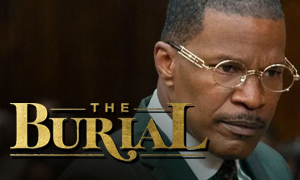Just Mercy: History vs. Hollywood
| REEL FACE: | REAL FACE: |
Michael B. Jordan
Born: February 9, 1987 Birthplace: Santa Ana, California, USA | Bryan Stevenson
Born: November 14, 1959 Birthplace: Milton, Delaware, USA Walter McMillian's Attorney |
Jamie Foxx
Born: December 13, 1967 Birthplace: Terrell, Texas, USA | Walter "Johnny D." McMillian
Born: October 27, 1941 Birthplace: Monroeville, Alabama, USA Death: September 11, 2013 |
Brie Larson
Born: October 1, 1989 Birthplace: Sacramento, California, USA | Eva Ansley
Operations Director at the Equal Justice Initiative (Pictured in the Decades Following McMillian's Release) |
Tim Blake Nelson
Born: May 11, 1964 Birthplace: Tulsa, Oklahoma, USA | Ralph Myers
Witness Who Later Recanted His Testimony Against McMillian |
Karan Kendrick
Born: abt 1976 Birthplace: Fort Valley, Georgia, USA | Minnie McMillian
Walter McMillian's Wife |
Rafe Spall
Born: March 10, 1983 Birthplace: Camberwell, London, England, UK | District Attorney Tommy Champan
Maintained Walter McMillian was Guilty, Despite Ralph Myers Confessing to Lying on the Stand |
Rob Morgan
| Herbert Richardson
Death: August 19, 1989 (electric chair) Bryan Stevenson was unable to stop Richardson's execution. |
Was Walter McMillian targeted because he was having an affair with a white woman?
The Just Mercy true story confirms that this is what both Walter McMillian and J. L. Chestnut (the attorney who initially defended him) believed was the reason he had been sought out for the murder. McMillian, a father of nine who held two jobs, was known in the community for having an ongoing affair with a white woman named Karen Kelly (pictured below during a 60 Minutes interview). In addition, one of McMillian's sons had married a white woman. Walter McMillian had violated the racial and sexual taboos of the small Alabama town in which he lived.
"The only reason I'm here is because I had been messing around with a white lady and my son married a white lady," McMillian said in a prison interview." -The New York Times
How much time passed between Ronda Morrison's murder and the arrest of Walter McMillian?
In answering the question, "How accurate is Just Mercy?" we learned that it took more than six months for the newly elected sheriff, Tom Tate, to arrest Walter McMillian in relation to the November 1, 1986 murder of an 18-year-old white woman, Ronda Morrison. Her body had been discovered at her place of employment, Jackson's Dry Cleaners in Monroeville, Alabama. Sheriff Tate had been under pressure to produce a suspect.
Did Walter McMillian have a solid alibi that proved he couldn't have murdered Ronda Morrison?
Yes. When 18-year-old community college student and dry-cleaning clerk Ronda Morrison (pictured below) was shot multiple times at Jackson's Cleaners on the morning of Saturday, November 1, 1986, Walter McMillian and his wife Minnie were hosting a fish fry at their home, where he was surrounded by dozens of witnesses. The purpose of the fish fry was to recruit new members for their church congregation (they didn't have an actual church building yet). At the trial, McMillian's lawyer put a dozen witnesses on the stand who all testified that McMillian was helping with the fish fry on the morning of the murder.
Was the real Walter McMillian locked up on Death Row before he was even tried?
Yes. A Just Mercy fact check confirms that shortly after his arrest, McMillian was sent to Alabama's Death Row at Holman State Prison, Atmore. This was almost an unheard-of decision, given that he had yet to be convicted. Judge Robert E. Lee Key, Jr. also moved McMillian's trial from Monroe County (40 percent black) to Baldwin County (13 percent black). As a result, the jury was all white except for one person. -The New York Times
Did the witnesses who placed Walter McMillian at the fish fry on the morning of the murder include a police officer?
Yes. According to Bryan Stevenson's book Just Mercy, the witnesses who placed Walter McMillian at the fish fry at the exact time of the murder included a police officer.
Did Sheriff Tate really tell Walter that he was going to "put twelve people on a jury who are going to find your goddamn black ass guilty"?
According to reports, this is indeed what Sheriff Tom Tate told Walter McMillian after McMillian tried to explain that he was at home hosting a fish fry on the morning of November 1, 1986, when Ronda Morrison, a white woman, was murdered. Tate responded, "I don't give a damn what you say or what you do. I don't give a damn what your people say either. I'm going to put twelve people on a jury who are going to find your goddamn black ass guilty." -The Washington Post
Is Just Mercy based on a book?
Yes. The movie is based on lawyer Bryan Stevenson's 2014 bestselling memoir Just Mercy: A Story of Justice and Redemption. Stevenson is portrayed by Michael B. Jordan in the movie. Interestingly, the real-life events in Just Mercy unfold in Monroeville, Alabama, which is the birthplace of Harper Lee, author of the similarly-themed (fictional) book To Kill a Mockingbird. The racist attitudes Lee observed in her hometown of Monroeville helped to inspire the characters in her 1960 novel.
Another book about Walter McMillian's wrongful incarceration is journalist Pete Earley's 1995 true crime book Circumstantial Evidence: Death, Life, and Justice in a Southern Town. We used both books to investigate the Just Mercy true story.
Was there any physical evidence that tied Walter McMillian to the murder?
No, a Just Mercy fact check confirms that there was zero physical evidence that tied McMillian to the murder of Ronda Morrison. There was also no motive. -The New Yorker
Did the real Walter McMillian have any prior convictions?
No. The only mark on McMillian's record had been a misdemeanor charge from a bar fight. He had no history of violence (The New York Times). However, the movie does leave out the more unsavory side of McMillian. For instance, Pete Earley's book Circumstantial Evidence states that McMillian was a small-time marijuana dealer. In addition to discussing his affair with Karen Kelly, the book talks about weekends McMillian spent at nightclubs. Of course, none of these things mean he's guilty in the murder. It just means he had some rough edges that the movie sanded off.
Was the judge at the trial really named "Robert E. Lee"?
Yes. As hard as it is to believe, the judge who oversaw Walter McMillian's 1988 trial was Judge Robert E. Lee Key, Jr., named after the commander of the Confederate States Army in the American Civil War.
Was the jury almost all white?
Yes. The jury at Walter McMillian's trial was made up of eleven whites and one African American. On August 17, 1988, they found McMillian "guilty of the capital offense charged in the indictment" and agreed on a sentence of life in prison. However, the judge overruled the jury and levied the most extreme punishment.
How long did the trial last?
As we looked into how accurate is Just Mercy, we learned that it took the jury just a day and a half to find Walter McMillian guilty.
Was Walter McMillian convicted based on suspect testimony?
Yes. His conviction was largely based on the testimony of career criminal Ralph Myers, a white man who had been arrested in connection with a murder in nearby Escambia County. Following a week of being interrogated by the police, Myers accused McMillian of murdering 18-year-old Ronda Morrison. At the trial, he testified that he had given McMillian a ride to the dry cleaners where he witnessed him murder Morrison, the store's clerk. Myers pled guilty as a conspirator in the murder. The scars on Myers's face, which were recreated for the movie, were the result of a childhood fire.
A second criminal suspect testified that he observed McMillian's "low rider" truck not far from the cleaners. Two other informants also connected McMillian to the murder. -The New York Times
Was Walter McMillian sentenced to death despite the jury only giving him a sentence of life in prison?
Yes. At the time of the 1988 trial, a controversial Alabama doctrine called "judge override" allowed Judge Robert E. Lee Key, Jr. to levy the death penalty, overriding the jury's sentence of life in prison. Like in the movie, Judge Key stated that McMillian needed to be put to death for the "brutal killing of a young lady in the first full flower of adulthood." -The New Yorker
Ralph Myers, who pled guilty as a conspirator in the murder, was given 30 years in prison.
Did the police pull their weapons on attorney Bryan Stevenson during a traffic stop in Alabama?
Not exactly. There was an incident in which a police officer pulled his weapon on Stevenson, but it didn't happen during a traffic stop in Alabama. It happened when Stevenson was sitting in his car outside an apartment he had in Atlanta. He had arrived home late from work and was finishing listening to a song that had come on the radio. A woman in the apartment building called the police because there had been several burglaries in the area, and she became concerned when she saw Stevenson sitting in his car outside the building. Two officers arrived on the scene and when Stevenson started to open his car door, one of the officers unholstered his pistol and yelled, "Move and I'll blow your head off!" The other officer pulled Stevenson from his car, pinned him against the hood and frisked him. -Circumstantial Evidence
Did Bryan Stevenson fail to save Herbert Richardson from the death penalty?
Yes. Herbert Richardson, portrayed by Rob Morgan in the Just Mercy movie, was a Vietnam veteran and a real-life client of Bryan Stevenson. It's true that Stevenson failed to save Richardson from the death penalty. The movie doesn't delve into why Richardson was on Death Row. Richardson had PTSD from his time in Vietnam and struggled with psychological difficulties. He ended up at a Veterans Affairs hospital in New York after he returned from the war. He began dating a nurse at the hospital. When she moved to Alabama, he followed but the two broke up. To win her back, Richardson planted a bomb on her porch and planned to save her from it. However, her 10-year-old niece picked up the bomb and was killed instantly when it exploded.
Other parts of Herbert Richardson's story are changed slightly. For instance, he didn't tell the Army to send the flag from his funeral to Bryan Stevenson. In real life, he urged Stevenson to send it to a woman he had married while in prison. An aspect of his story that the movie gets right is that he really did play "The Old Rugged Cross" over the prison's P.A. system on the night that he was executed. -Just Mercy book
Was Walter McMillian's son Johnny tackled by courtroom deputies?
Yes. In real life, this supposedly happened during the reading of the initial guilty verdict, prior to when Bryan Stevenson became involved in the case. According to Sheriff Tate, Johnny exclaimed, "Somebody's going to pay for what they've done to my father."
When did Bryan Stevenson take Walter McMillian's case?
The Just Mercy true story reveals that the real Bryan Stevenson took the case in 1988, the year of McMillian's murder conviction. Michael B. Jordan depicts Stevenson in the movie, while Jamie Foxx plays McMillian.
Did a white prison guard have a change of heart after initially forcing Bryan Stevenson to undergo a strip search before meeting with a client?
Yes, but the guard's change of heart didn't happen while Bryan Stevenson met with Walter McMillian on Death Row. In real life, it happened when Stevenson was meeting with a different client who was at a different prison. The white guard had a change of heart after hearing Stevenson tell the court about the awful abuse his client endured in the foster system. It just happened that the guard had been a former foster kid too.
How many times did Walter McMillian appeal his murder conviction?
In analyzing the Just Mercy fact vs. fiction, we confirmed that after turning down four appeals, the Alabama Court of Criminal Appeals finally reversed the lower court conviction in 1993, ruling that the judge and District Attorney Theodore Pearson "had practiced intentional racial discrimination in jury selection."
Is Brie Larson's character, Eva Ansley, portrayed accurately in the movie?
From the information available about the real Eva Ansley, it seems that the movie rather accurately captures her role in helping Bryan Stevenson with Walter McMillian's case, along with her role at the Equal Justice Initiative, which she formed with Stevenson in 1989 and still holds the title of Operations Director. Ansley, while not an attorney, instead helps coordinate legal services for the poor and works to match death row prisoners with lawyers.
One thing that the Just Mercy movie somewhat fictionalizes is when Eva Ansley (Brie Larson) offers a piece of her mind to a landlord in Montgomery who refuses to rent them office space because of the type of work they're doing. Something sort of similar happened in real life. Stevenson notes in his book that the University of Alabama School of Law in Tuscaloosa had promised to give them office space, then changed their mind.
How long did Walter McMillian spend on Death Row?
A Just Mercy fact check reveals that the real Walter McMillian served six years on Alabama's Death Row before his conviction was finally overturned.
What led to Walter McMillian being set free?
Lawyer Bryan Stevenson's efforts to expose the perjured testimony made by criminal witnesses, including evidence withheld from Walter McMillian's lawyers that revealed the witnesses' testimony to be a lie, led to the conviction being overturned. Three of the witnesses for the prosecution subsequently recanted their testimony. Ralph Myers said that officers "coerced" him into implicating himself and McMillian and that his statements were "bogus." He had initially told police that he had no knowledge of McMillian's involvement and didn't know him. Myers's description of the placement of the body was entirely wrong, among other things.
The testimony of the two witnesses who claimed to see McMillian's low rider truck not far from the location of the murder was discredited when Stevenson learned that McMillian didn't convert his truck to a low rider until six months after the murder. The witnesses then admitted they lied at the trial. -The New York Times
It also came to light that District Attorney Theodore Pearson "had concealed evidence proving McMillian's innocence" when it was discovered that there was a witness who had seen Ronda Morrison alive after the time that prosecutors said McMillian had murdered her.
Perhaps the most damning piece of evidence to vindicate McMillian came when McMillian's attorneys obtained the original tape of Ralph Myers's confession. One side contained a recording of Myers implicating McMillian, but when they flipped the tape over, they discovered a recorded conversation in which Myers vehemently protested being forced to implicate Walter McMillian, stating that he did not know the man, nor did McMillian play any role in the murder.
It is believed that had Judge Robert E. Lee Key, Jr. not stepped in and given McMillian the harsher sentence of death in the electric chair, the jury's initial sentence of life in prison would have resulted in McMillian's case being overlooked by social justice activists and Civil Rights lawyers like Bryan Stevenson. "The fortunate thing about Mr. McMillian's case is his innocence was demonstrable," Stevenson said. "It's clear he had nothing to do with this crime. There are other folks in prison who don't have the money or the resources or the good fortune to have folks come in and help them." -The New York Times
Who really murdered Ronda Morrison?
In exploring the Just Mercy accuracy, we discovered that Ronda Morrison's killer was never found. Seven years after her murder, her parents published a memorial in The Monroe Journal. It concluded with the statement, "Ronda, we will always miss you and we pray that those responsible will someday be arrested."
What happened to Walter McMillian?
The real Walter McMillian filed a civil lawsuit against local and state officials involved in the murder investigation that resulted in him being wrongfully accused and ending up on Death Row. Some of the individuals named in the suit included Monroe County Sheriff Tom Tate, D.A. investigator Larry Ikner, and Alabama Bureau of Investigation agent Simon Benson. The suit against Sheriff Tate was appealed to the U.S. Supreme Court, which ruled in favor of Tate, stating that the sheriff of a county could not be sued for monetary damages. The suits against the other officials were settled for undisclosed amounts. -WALTER McMILLIAN, PETITIONER v. MONROE COUNTY, ALABAMA
McMillian's case did lead to a limited amount of positive change. It helped to inspire Alabama's 2001 compensation statute.
Walter McMillian broke his neck while cutting a tree in 1995 and went on partial disability. He found work hauling junkyard cars for scrap metal. He developed early-onset dementia and passed away in 2013 at age 71. His lawyer, Bryan Stevenson, and his family believe that the six years of excruciating torment he experienced on Death Row, in addition to the PTSD he endured in the years after his exoneration, played a significant part in his illness and death.
Walter McMillian Interview & Related Videos
How accurate is Just Mercy? Gain even more insight into the true story behind the movie by watching the videos below, which include Walter McMillian and Bryan Stevenson interviews.







